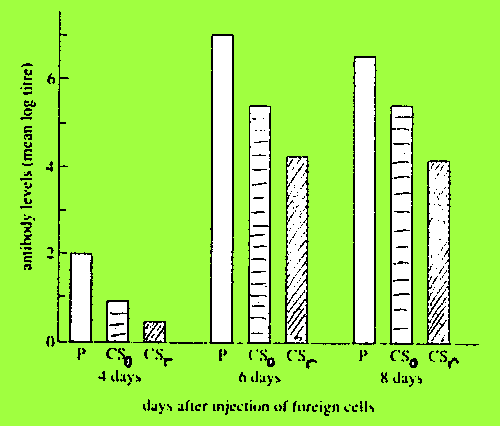Immunity (Ch. 5)
Back to neuro-revision list or Tutorial
7 notes or BBB Home Page
The immune system:
A vast, diffuse lymphoid system, including bone marrow, spleen, lymph nodes
(glands), cells of the reticulo-endothelial system (macrophages) and circulating
white blood cells (leukocytes).
Function: defence. Identification and destruction/inactivation of 'foreign'
(non-self) material, e.g. pathogens - bacteria, viruses, toxins.
Immunity
The immune system identifies 'foreign' material by its chemical nature
(antigen)
On first exposure to an antigen, the immune response is slow, taking
about one week to mobilise an effective defence. Thus, many pathogens (e.g.
viruses) cause overt disease the first time they invade.
However, 'memory cells' (see below) in the system 'remember' this antigen
and the next time it is encountered, the response is very rapid. 'Immunity'
has been established, and the disease does not recur. The immune 'memory'
is longlasting.
Mechanisms of defence:
Phagocytosis - ("cell-eating") some white cells (polymorph neutrophils,
macrophages) can engulf and destroy pathogens.
Cytotoxicity - killing or immobilising pathogens with 'poisons'
secreted from the white cells.
Inflammation - tissue and vascular reaction that isolates the
pathogen. and allows access of defence cells to site of invasion or damage.
Humoral immunitv - antibodies. Antibodies are specific chemicals
produced in response to 'foreign' antigens. They do not actually 'kill'
pathogens carrying the antigens, but they 'label' them as foreign, identifying
them for attack by defence cells.
(In some diseases - auto-immune diseases - antibodies are produced against
the body's own cells, which are then attacked by the host's own immune
system.)
Lymphocytes:
Small lymphocytes are unique in that they are the only type of white cell
that has an 'immune memory'. After exposure to a particular antigen, some
of the small lymphocytes involved in the response convert into 'memory
cells', capable of responding rapidly to this antigen, should it be encountered
again (even after many years). There are different types of small lymphocyte:
-
B-lymphocytes: are the source of circulating antibodies. For each
antigen encountered, there is a set of B-lymphocytes (a clone) to produce
a specific antibody in response to the antigen. There are many, many different,
specific B-lymphocytes.
-
T-lymphocytes : there are several different types -
-
Killer (cytotoxic) T-cells - responsible for cell-mediated immunity
-
Suppressor T-cells & Helper T-cells modulate
the immune reactions through chemicals - lymphokines which can inhibit
or enhance the actions of other defence cells.
There are many similarities between lymphokines and neurotransmitters.
Small lymphocytes have receptors that can bind a wide range of neurotransmitters,
e.g. opioid peptides, hormones, catecholamines. This raises the possibility
of interactions between neurons and immune cells.
Some neurons secrete lymphokines (It is not certain if these have an
immune function, or if it merely reflects the common embryonic origins
of these cells.)
Neural control of the immune system
Lymphoid organs are innervated by autonomic (sympathetic) nerves. White
cells in lymphoid organs carry adrenoreceptors. Thus in theory, autonomic
nerves could control the function of these white cells. There is some evidence
that blocking these adrenoreceptors can depress lymphokine release by the
white cells.
Does the nervous system influence the immune system?
Classical conditioning of the immune response
Rats become ill when given an injection of cyclophosphamide (CPA). CPA
is a cytotoxic drug used for treating some tumours, and which kills rapidly
dividing cells, including some responsible for the immune response; thus
CPA depresses the immune response. If the CPA injection (UCS) is accompanied
by saccharin-flavoured water (CS), the rats associate the illness with
the saccharin flavour - and they will avoid this flavour in the future.
(A classically conditioned avoidance response). If the CPA-treated rats
are later given saccharin-flavoured water, but without further doses of
CPA ('extinction conditions'), they still display a long-standing aversion
to the saccharin (as expected), but some rats continue to show a profound
depression of the immune response. This was not simply due to prolonged
action of the CPA. In the animals given an injection of CPA paired with
saccharin-flavoured water there is a greater suppression of the immune
response if they are given saccharin-flavoured water (CSr) afterwards
than in other rats that drink only plain water afterwards (CS0).
Levels of antibodies in the blood of rats at various times after immunization
with foreign cells. P is the placebo group, given a sham injection (i.e.
no CPA) and plain drinking water. CS0
animals were given one
dose of CPA paired with saccharin, and drank plain water thereafter. CSr
animals received one dose of CPA paired with saccharin, but were re-exposed
to saccharin-flavoured water daily thereafter. (Book 2, Fig 5.8)
Thus, the immune response can be suppressed by classical conditioning.
This raises the possibility that such immunosuppressive conditioning could
be used instead of immunosuppressant drugs for reducing the rejection of
tissue grafts and even for the treatment of autoimmune diseases.
The functioning of the immune system can also be impaired by the effects
of STRESS.
Back to neuro-revision list or Tutorial
7 notes or BBB Home Page
